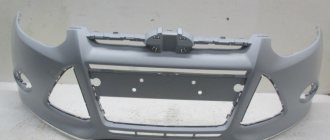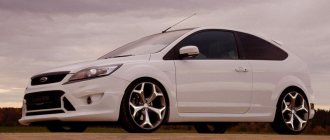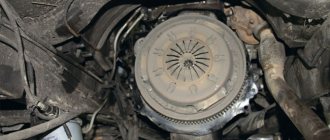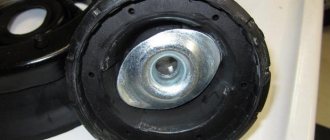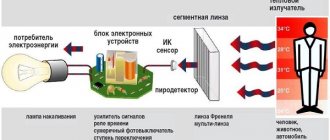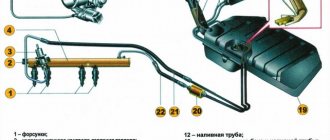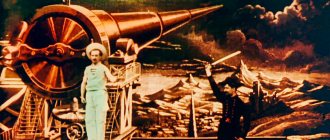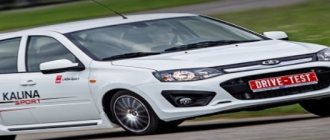How to properly make a U-turn on the road?
Details Category: Driving school Published 09/21/2019
Today we will talk about how to properly make a U-turn on the road.
Today's article will focus on the rules for safe and convenient turning on the road.
U-turn on a two-lane road
The easiest option is to make a U-turn on a two-lane road. If there are no continuous markings on the road or a sign prohibiting turning, it is enough to:
- turn on the left turn signal;
- let oncoming traffic pass;
- make sure that no one is overtaking or driving around you from behind.
- Turn the steering wheel all the way to the left and make a U-turn.
You need to remember - if the width of the road does not allow you to make a U-turn, you can turn around using the side of the road - traffic regulations do not prohibit this. At the same time, you will need to give way to all traffic participants, both from the oncoming direction and from the same direction.
How to make a U-turn correctly
Now we’ll tell you how to correctly approach a U-turn, which is usually located on a multi-lane road with a median.
The most important condition in traffic rules is to enter a U-turn from the far left lane. Driving from the second lane is a serious violation and often leads to accidents.
Another common question from novice drivers is what is the best place to take a U-turn? Many turns allow several cars to park on them at once. According to the current traffic regulations, the driver, when exiting a turn, will be required to yield to the car that is on the right (“interference on the right”). Thus, if you do not want to give way to anyone, it is better to stand at the very end of the turn - then you will be on the right relative to all other cars. At the same time, in this case you will also block the entrance to the turn for violators who are trying to go around everyone in the second row and wedge in at the end of the turn.
It only makes sense to get up at the beginning of a turn when you plan to exit it into the far left lane for a subsequent turn or U-turn.
Another important rule: when making a turn, do not turn the steering wheel in advance and keep the brake pedal pressed. In the event of a rear impact with the wheels turned out, your car will fly straight into the oncoming lane, which will lead to a serious accident.
How to exit a U-turn correctly
According to traffic rules, when exiting a U-turn, you can take any free lane. If the trajectories of cars leaving a turn intersect, you need to give way to the drivers who are on your right.
If there is no traffic light installed at the turn itself to regulate traffic, you can exit the turn only if there are no cars approaching from the opposite direction.
Often, acceleration lanes are made opposite the U-turns from the oncoming side of the road. If there is such a lane, you need to exit the turn straight there. You can change to the main lanes only after accelerating in the acceleration lane, so as not to interfere with other road users.
Where can't you turn around?
In addition to the turning car, there are a lot of other traffic participants on the road. As a result of this, the maneuver must be performed in such a way that the rights of other drivers are not violated and an emergency situation is not created.
According to traffic rules, you cannot turn around:
- through a solid line (two solid ones);
- inside the tunnel;
- at bus stops;
- at pedestrian crossings;
- on escalades, bridges and under them;
- in case of poor visibility on the road (does not exceed 100 meters);
- at railway crossings.
All these rules are described in detail in the Traffic Regulations, clause 8.11. The most important thing when maneuvering is to sensibly assess the situation and have a good overview.
Where it is prohibited to turn a car and signs prohibiting a turn
U-turns at a pedestrian crossing or zebra crossing are prohibited. Moreover, it is worth considering that before and after the transition, the maneuver is possible. How to find out the boundaries of a pedestrian crossing if there is no zebra crossing or it is invisible, for example, in winter? Focus on the signs, usually there are two of them (on opposite sides of the road) - the distance between the signs determines the location of the zebra.
It is logical that the confined space and low light do not allow drivers to turn around in tunnels. On bridges, overpasses and the space under them, overpasses - the ban is due to the fact that such structures usually limit the visibility zone - drivers simply cannot correctly assess the situation.
At public and route transport stops, as they are always characterized by large crowds of people, which will not allow motorists to turn around there safely. Remember that you cannot turn around within 15 meters on either side of a stop sign or marking (yellow zigzag line).
At railway crossings – potentially dangerous sections of the road that require increased concentration. The ban begins from the place where barriers or corresponding road signs are installed. If the road is poorly visible in at least one direction, then visibility is less than 100 meters.
Prohibiting U-turn signs:
- signs indicate that pedestrians are crossing the road at a given place (5 19 1; 5 19 2; 1 14 1; 1 14 2);
- sign indicating the entrance to the tunnel (1 31);
- signs indicating the boundaries of railway crossings (1 3 1; 1 3 2);
- signs warning of poor road visibility (1 11 1; 1 11 2; 1 12 1; 1 12 2);
- signs informing about the presence of a public transport stop (5 16; 5 17; 1 17);
- signs prohibiting a turn, indicating the direction of movement (1 19; 4 1 1; 4 1 2; 4 1 4);
- double or single solid line signs (1 2 1; 1 3).
Traffic rules at the intersection of roads with a dividing strip
Significantly more questions arise when performing a maneuver at the intersection of roads, one of which is equipped with a dividing strip. In fact, such an intersection has two sections of intersection of roadways.
A turn in such a place is accomplished in two ways:
- If the dividing line reaches the border of the intersection of roadways, then the maneuver is performed along a large radius.
- If the dividing line does not reach the border of the intersection of roadways, the car turns around without entering the intersection.
The long-distance turning rule also applies at intersections with a very wide dividing line.
U-turn technique
Much attention is paid to the turning technique. An experienced driver understands perfectly well the responsibility for an incorrectly performed maneuver. It is allowed to make a turn in one, two or three steps . When using any of these techniques, it is important to understand that moving backward is not always allowed.
A one-step turn is performed like this:
- a place for a turn is selected and the turn signal is turned on;
- depending on the turning radius, you can press close to the right edge of the road, having previously warned other drivers about moving to the right;
- slow down or stop altogether;
- using a mirror, you need to make sure that there are no obstacles, start slowly moving forward and turn around;
- Align the car's wheels and continue driving.
Two-step turns are often used when adjacent areas are available. You can enter this area in reverse, having first pressed against the side of the road on the right. Next, make a turn without interfering with other drivers.
Three-turn turns are appropriate on very narrow roads where a reverse maneuver is required. In this case, you need to be extremely careful and evaluate the movement from all sides to avoid an accident. Reverse movement is made 1.5 meters before the nearest curb . If any terms are unclear to you, use the free service of our website - seek advice from our lawyers.
Performing a maneuver at a regular controlled intersection
You can turn a car around at a regular intersection with one intersection of roadways along a large or small trajectory.
Algorithm for turning around at a controlled intersection:
- Move your car into the leftmost lane in advance.
- When the traffic light turns on, drive to the center of the intersection.
- Give way to oncoming cars and complete the maneuver.
Rules
If you own a large vehicle, then it is better not to make a U-turn at a T-shaped intersection. The maneuver must be carried out without reversing, otherwise you may face a fine of 500 rubles.
For different situations, there is a different order of actions that must be performed when turning at a T-shaped intersection, depending on the position you are in relative to the adjacent road. Of course, you should pay attention to the signs at the intersection.
When making a U-turn at a T-shaped intersection, you should pay attention to which road is the main one, where the “give way” sign is located, and whether there is a “stop” sign. If the intersection is unregulated or there are no signs, then you should be guided by the “interference on the right” principle. Let's look at different situations in which such a reversal can be carried out and the order of actions that will need to be taken.
What do turning left and making a U-turn have in common?
Turns and left turns are destroyed in the absence of prohibitory signs. These concepts are connected by the beginning of the maneuver - the turn signal must turn on, the car turns left. Only when turning, the car continues along the selected lane, and when turning, it occupies the lane of oncoming traffic and moves in the opposite direction.
Changing lanes within the same direction is not considered a turn or a U-turn. This maneuver is called changing lanes, although it requires turning on your turn signals.
Pulling onto the side of the road is also not considered a turn. But entering a parking space, including near public places, is considered a turn.
Traffic rules
Dear readers! The article talks about typical ways to resolve legal issues, but each case is individual. If you want to find out how to solve your particular problem , contact a consultant:
8 (800) 700 95 53
APPLICATIONS AND CALLS ARE ACCEPTED 24/7 and 7 days a week.
It's fast and FREE !
Traffic rules require compliance with both general requirements for behavior on the road and specific ones that apply in certain situations and in the presence/absence of certain signs.
The rules for turning at an intersection, in particular, state that you cannot cross the oncoming and adjacent lanes, turning is only allowed from a row adjacent to the dividing line, and you cannot drive onto the sidewalk, as this leads to loss of control.
It is important to remember that on the road in general and, in particular, at intersections, you cannot use reverse, which further aggravates the situation, complicating the already difficult procedure of turning around. You can only reverse when entering areas adjacent to the road, for example, courtyards or local widenings.
Traffic regulations distinguish two main types of turns at an intersection - small and large radius, which are also called near and far trajectories.
